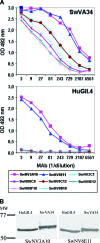Self-assembly of the recombinant capsid protein of a swine norovirus into virus-like particles and evaluation of monoclonal antibodies cross-reactive with a human strain from genogroup II
- PMID: 18842943
- PMCID: PMC2593275
- DOI: 10.1128/JCM.01204-08
Self-assembly of the recombinant capsid protein of a swine norovirus into virus-like particles and evaluation of monoclonal antibodies cross-reactive with a human strain from genogroup II
Abstract
Noroviruses (NoVs) are responsible for the majority of gastroenteritis outbreaks in humans. Recently, NoV strains which are genetically closely related to human genogroup II (GII) NoVs have been detected in fecal specimens from swine. These findings have raised concern about the possible role of pigs as reservoirs for NoVs that could infect humans. To better understand the epidemiology of swine NoVs in both the swine and the human populations, rapid immunoassays are needed. In this study, baculovirus recombinants were generated to express the capsid gene of a swine NoV GII genotype 11 (GII.11) strain which self-assembled into virus-like particles (VLPs). Subsequently, the purified VLPs were used to evoke monoclonal antibodies (MAbs) in mice. A panel of eight promising MAbs was obtained and evaluated for their ability to bind to heterologous VLPs, denaturated antigens, and truncated capsid proteins. The MAbs could be classified into two groups: two MAbs that recognized linear epitopes located at the amino-terminal half (shell domain) of the swine NoV GII.11 VLPs and that cross-reacted with human GII.4 NoV VLPs. The other six MAbs bound to conformational epitopes and did not cross-react with the human GII.4 VLPs. To our knowledge, this is the first report on the characterization of MAbs against swine NoVs. The swine NoV VLPs and the MAbs described here may be further used for the design of diagnostic reagents that could help increase our knowledge of the prevalence of NoV infections in pigs and the possible role of pigs as reservoirs for NoVs.
Figures




References
-
- Atmar, R. L., and M. K. Estes. 2006. The epidemiologic and clinical importance of norovirus infection. Gastroenterol. Clin. N. Am. 35275-290, viii. - PubMed
-
- Barcena, J., N. Verdaguer, R. Roca, M. Morales, I. Angulo, C. Risco, J. L. Carrascosa, J. M. Torres, and J. R. Caston. 2004. The coat protein of rabbit hemorrhagic disease virus contains a molecular switch at the N-terminal region facing the inner surface of the capsid. Virology 322118-134. - PubMed
-
- Batten, C. A., I. N. Clarke, S. L. Kempster, S. L. Oliver, J. C. Bridger, and P. R. Lambden. 2006. Characterization of a cross-reactive linear epitope in human genogroup I and bovine genogroup III norovirus capsid proteins. Virology 356179-187. - PubMed
Publication types
MeSH terms
Substances
LinkOut - more resources
Full Text Sources
Other Literature Sources
Medical

